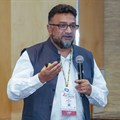#WorldToiletDay: Catalysing a new sanitation paradigm for South Africa

Toilets provide an important medical function by separating users from faecal material which can be the source of many waterborne illnesses, including Cholera and diarrhoea, and soil-transmitted diseases, such as intestinal worms. The lack of hygienic toilet facilities has detrimental consequences to humans. The World Health Organisation estimates that inadequate sanitation causes 432,000 diarrhoeal deaths with mainly young children susceptible.
The lack of sanitation also contributes to malnutrition, lost educational opportunities and associated with a lack of dignity. The knock-on effects on a country can be significant. It was estimated poor sanitation cost the global economy around R3tn ($222bn) mainly through mortality, loss of productivity, burden on healthcare for preventable diseases and the time used for locating access to a toilet.
Important medical device
Despite the many societal benefits of providing hygienic sanitation, there are approximately 2 billion people who still do not have basic sanitation facilities with nearly 700 million people around the world that have to relieve themselves in bushes, in water and in the streets. This is eye-opening considering a hygienic toilet is one of your home’s most important medical devices yet for many, there is evidence suggesting that some have no such option.
World Toilet Day serves a reminder and an inspiration for the world to tackle the global sanitation challenge. The theme for World Toilet 2019 is “Leaving no-one behind” and is linked to Sustainable Development Goals, specifically Target 6, which is to eliminate defaecating in the open and to ensure that everyone has access to sustainable services by 2030.
It has been 50 years since the first manned Apollo 11 mission to land on the Moon and numerous human technological advances since then. Yet, as a global community, we have not figured out how to achieve universal sanitation access, one of human beings' most basic needs. Why do we struggle and what are the challenges – despite the numerous benefits associated with sanitation provision? There are many reasons but these are symptoms of a lack of technical options in the way we provide toilet facilities which is limited to two extreme constraints: full flush linked to sewers and dry sanitation in the form of latrines.
Same design since 18th century
Full flush toilets connected to sewers are mainly found in urbanised areas within South Africa. It may be startling to know but the basic design of the flush toilet has not changed considerably since the late 1700’s. The S-shaped pipe that you find at the bottom of toilet and connecting to the wall of your home and a sewer system is the same design that has been used since the 1700’s. The water inside the toilet bowl of your flush toilet serves as an odour trap while the flushing water is used a transport medium to remove the faecal waste into sewer systems.
There has little innovation in toilet design for over a 100-years. In urban South African homes, around 6-9 litres of potable water – water that is perfectly safe for human consumption – is used to do this. Globally, this strategy has resulted in a significant reduction of waterborne illnesses. But in South Africa, which experiences uneven rainfall distribution water stress in various parts of the country, this approach may not be viable in the long-term. At the moment, many parts of the country are experiencing heatwave conditions and there is concern over water supply. Requests have been made by water utilities to use water more sparingly as residents' water consumption increased during the heatwave conditions.
Flushing away potable water
Herein exists an opportunity to reduce or recycle water for flushing. Toilet flushing contributes to around 30% of household water use. It seems illogical that we could use clean, drinkable water which is of limited supply to flush our urine and faeces. Would people use 6-9 litres of coldrink or fruit juice to flush their faecal waste? It can be assured that the answer would probably be no and probably indicates how little we consider the value of water – until we have little or none.
It is anticipated that with high urbanisation trends and population growth, more people will desire to be connected to the sewer system resulting in more potable water flushing and increasing pollution load volumes to be treated. One of the main reasons why South Africa cannot implement sewers throughout the country is that the technical option is costly; South Africa is water stressed and cannot afford to flush away potable water, sewer laying is a time-consuming and costly exercise and sewer-based treatment systems are significantly more expensive to operate, maintain and implement than other options. If water-based sewer systems are costly, what are the other options available?
On-site sanitation systems
On the opposite side of the technical spectrum are on-site sanitation systems. These systems do not need to be connected to a sewer and are common outside urban centres. Septic tanks are considered as an on-site sanitation system but by far, the most common system used in rural and peri-urban settlements are latrines – also commonly called “long drops”. As the name suggest, faecal waste “drops” into a hole in the ground. The best attribute of the technology is that is does not require water to function thereby saving water and the need for sewer pipes. This solution was designed to be temporary and is difficult to manage as the number of users is highly variable, the toilets can fill quickly and requires emptying. The cost associated with the disposal of viscous, sticky paste called faecal sludge can be significant. With limited options available, municipalities have little choice but to implement costly solutions which are not sustainable over the long-term. Clearly, there is a need for new and innovative toilets that close the gap between aspirational flush-styled toilets and rudimentary pit latrine toilets which do not need sewers and save water while not requiring any sludge handling and disposal.
The Water Research Commission (WRC) based in Pretoria was established in terms of the Water Research Act (Act No 34 of 1971) with one of its mandates to stimulate and fund water research according to priority. Together with national and international stakeholders, the WRC has been actively focused on developing sanitation solutions that fill the gap dictated by our country’s technical constraints. This includes the development of water-efficient flush toilets, like the Arumloo, that use up to three litres per flush. The hydrodynamic features of the Arumloo bowl has been copied from nature’s Arum Lily using biomimicry approaches. The product has been tested according to international flush standards and compares well to conventional full flush toilets but uses less water.
Creating a market for water-efficient products
Although the product is innovative, there is a need to create a market for water-efficient products within South Africa and policies that allow for the implementation of such innovations. A similar strategy was used by the US Environmental Protection Agency (EPA) to drive the implementation of water-saving flush toilets. In 1992, the US Energy Policy Act 1992 was enacted to lower the flush volumes of 13-19 litres per flush to around eight litres. This stimulated manufacturers to develop flush toilets that can operate effectively at this flush standard. This resulted in significant toilet water usage savings (over 50%) and indoor water use (16%). In 2007, through the US EPA WaterSense Programme, toilet manufacturers have been encouraged to develop greater flush efficiencies (six litres per flush). Products that achieved the WaterSense Programme flush standard could have their products marketed as water-efficient bathroom fixtures with flush performance accessed through independently certified testing centres.
The South African Sanitation Technology Enterprise Programme (SASTEP) driven by the WRC and involving national and international partners aims to achieve similar outputs. However, the programme is not only driving water-efficient toilets. It includes new, innovative toilets that negate the limitations of full flush toilets linked to a sewer and latrine-based technologies. SASTEP will support and accelerate the application and uptake of the latest cutting-edge toilets through evidence-based policy adjustments, demonstration, testing and science-based improvements towards localisation and industrialisation. This includes technologies supported by the Bill and Melinda Gates Foundation’s “Reinvent the Toilet” programme. The revolutionary toilet systems have water-saving or water-recycling features, are aspirational in design, and more importantly, can eliminate pathogens and sludge production at point-of-source without the need for sewers.
Finding creative, innovative solutions
For informal areas or areas with constrained water supply, these solutions could be central to providing sanitation services and saving countless lives. South Africa has become a test-bed for developing and demonstrating these solutions with a few recently highlighted in the Netflix docuseries “Inside Bill’s Brain” which highlights Bill Gates, Microsoft’s co-founder, drive to find creative and innovative solutions to sanitation provision. An important cog upscaling these new solutions is having appropriate process performance standards to ensure that the new toilets are able to meet a specific public health and environmental standard. This will ensure product durability and reliability and manufacturability.
Globally, process standards for these technologies have been adopted by the International Standards Organisation (ISO) with many countries adopting the new standard. On World Toilet Day, the American National Standards Institute (ANSI) will host a Non-Sewered Sanitation ISO training programme together with the Department of Water and Sanitation and the WRC that aims to facilitate understanding of the new technology standard. Further training courses are planned with innovators, the building industry, and municipalities. It is anticipated that the new toilet standard will provide impetus for creative and innovative thinking to develop appropriate sanitation solutions and services for South Africa and the region and thereby save many lives.


















